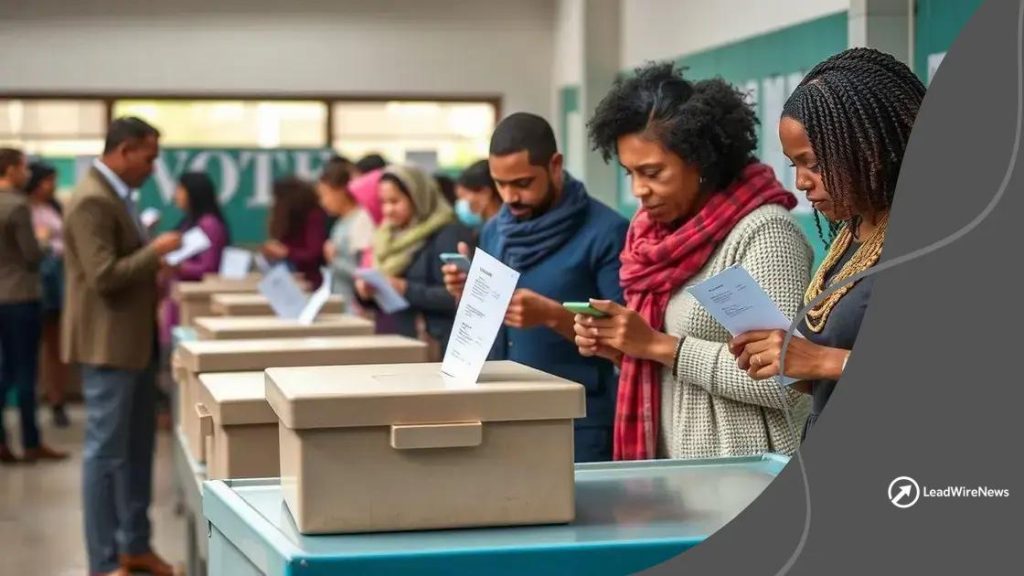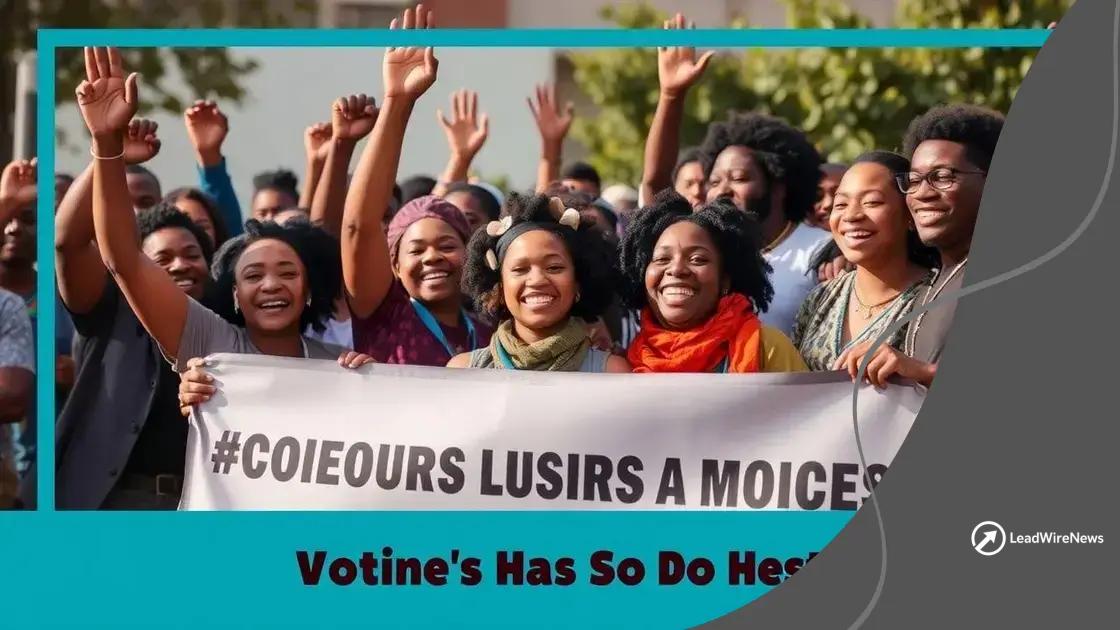Criminal justice reform ballot initiatives: what you need to know

Anúncios
Criminal justice reform ballot initiatives empower communities to influence laws by voting on measures that address systemic issues, enhance public safety, and promote fairness within the justice system.
Criminal justice reform ballot initiatives are gaining momentum across the nation, inviting voters to rethink traditional policies. Have you ever wondered how these initiatives shape our communities and impact lives? Let’s delve into their significance.
Anúncios
Understanding criminal justice reform initiatives
Understanding criminal justice reform initiatives is crucial as they play a significant role in shaping the legal landscape. These initiatives aim to address issues like over-incarceration and systemic inequalities.
Many states have recently introduced measures that put reform directly into the hands of voters. This grassroots approach enables communities to engage in real change. It’s fascinating to see how these movements evolve, often reflecting the public’s demands for fairness and justice.
Goals of Criminal Justice Reform
The primary focus of these initiatives includes:
Anúncios
- Reducing the prison population
- Implementing alternatives to incarceration
- Enhancing community-based programs
- Addressing racial disparities in sentencing
By understanding these goals, voters can better appreciate the impact of their choices at the polls. As people learn about these initiatives, they often find themselves more informed about the implications for their communities.
Key Components to Consider
Criminal justice reform initiatives often include several essential components. Common aspects to look out for are:
- Shifts in sentencing laws
- Funding for community services
- Measures to improve police accountability
These components are designed to not only target specific issues but also enhance the safety and well-being of communities. When voters support such initiatives, they signal a desire for comprehensive change.
Furthermore, successful reform initiatives often require broad coalitions. These coalitions bring together activists, lawmakers, and community members to create lasting change. The collaboration signals a unified effort to address the flaws within the system.
The impact of ballot initiatives on communities
Ballot initiatives significantly shape communities by providing residents a voice in crucial decisions. Understanding the impact of ballot initiatives on communities can help individuals realize their power in shaping legislation.
When a community supports a reform through a ballot initiative, it often reflects collective values and priorities. This is particularly true in areas like criminal justice reform, where public safety and fairness are at stake.
Positive Outcomes of Initiatives
Ballot initiatives can lead to various positive changes, including:
- Increased community engagement and awareness
- Improvement in local safety standards
- Support for mental health and rehabilitation programs
Communities that actively participate in these initiatives often see tangible benefits, as reforms address specific local concerns. By engaging in this process, citizens can directly influence the laws that govern their lives.
Challenges Faced by Communities
However, the journey isn’t always smooth. Communities face challenges like:
- Misinformation about proposed measures
- Opposition from established interests
- Voter apathy or disengagement
These challenges can hinder the effectiveness of ballot initiatives. A well-informed public is essential for the success of these measures. Education and outreach can empower communities to address these issues together.
In addition, community discussions and forums provide valuable platforms for discussing the potential effects and benefits of these initiatives. When residents come together to share their thoughts, it fosters a sense of unity and purpose.
Key examples of successful reforms

Exploring key examples of successful reforms provides valuable insights into the effectiveness of criminal justice reform ballot initiatives. These examples showcase how communities can enact change through voting.
One noteworthy case is California’s Proposition 47, which aimed to reduce certain nonviolent felonies to misdemeanors. This reform not only decreased the prison population but also increased funding for mental health and drug treatment programs.
Successful Reform Initiatives
Some additional examples of effective reforms include:
- The Second Chances Act in New Jersey focused on reentry programs for those released from prison.
- Measure 11 in Oregon introduced mandatory minimum sentences for certain crimes, which has been debated for its impact on recidivism rates.
- The decriminalization of marijuana in various states, contributing to significant tax revenue and reduced law enforcement costs.
These initiatives highlight how reforms can address specific problems, like overcrowded prisons and systematic inequalities. When communities engage in these efforts, they set in motion a ripple effect that can lead to lasting change.
Lessons Learned from Reforms
Amid the victories, it’s crucial to learn from the challenges faced during these reform processes. Community involvement was key to passing these initiatives. Advocacy groups mobilized voters, raising awareness about the benefits of reform. Additionally, transparent discussions about the implications of these laws fostered trust within communities.
Such lessons emphasize the importance of unity among citizens aiming for change. The road to reform can be difficult, but through collaboration and clear communication, communities can achieve meaningful progress.
Challenges faced in criminal justice reforms
Criminal justice reforms often face numerous challenges that can impede progress. Understanding these obstacles is vital for anyone interested in the criminal justice reform movement.
One major challenge is political opposition. Many lawmakers resist changes to traditional policies, fearing they may lose electoral support. This can stall important legislation that aims to improve the system.
Common Challenges in Reforms
Some of the key difficulties encountered include:
- Resistance from law enforcement agencies who may view reforms as threats to their authority.
- Lack of funding for new programs designed to support reform.
- Misinformation that misrepresents the goals and effectiveness of reforms.
This resistance can create substantial barriers, making it difficult to implement changes that communities desire. Moreover, public perception often swings based on media narratives, which can further exacerbate misunderstanding and resistance.
The Importance of Community Engagement
Community engagement plays a critical role in overcoming these challenges. When citizens become active participants in advocating for change, they can help shift public opinion. Grassroots campaigns often successfully educate others about the benefits of proposed reforms.
Additionally, forming coalitions with various stakeholders, including organizations, community leaders, and even law enforcement, can help bridge gaps. These collaborations encourage dialogue and foster understanding between different groups.
Despite the challenges, communities that remain persistent in their efforts can achieve meaningful change. Building awareness and support can pave the way for successful outcomes, ultimately leading to a more equitable criminal justice system.
How to get involved in reform movements
Getting involved in reform movements is essential for anyone who wants to make a difference in the criminal justice system. Individuals can play active roles in shaping policies that affect their communities.
One effective way to get started is by educating yourself and others about the issues at hand. Knowledge about criminal justice reform initiatives helps you become an informed advocate. You can participate in local workshops or online webinars that discuss various aspects of reform.
Steps to Engage in Reform Movements
Here are some ways to take action:
- Join local advocacy groups that focus on criminal justice reform.
- Attend community meetings to understand the needs and concerns of your neighbors.
- Volunteer your time to support campaigns or organizations working on these issues.
- Use social media to share informative content and raise awareness.
Connecting with like-minded individuals can create a network of support. This can amplify your voice and extend your reach. Collaboration with others makes the movement stronger and more effective.
Using Your Voice
Another crucial aspect of getting involved is making your voice heard. Write letters to your local representatives urging them to support reform initiatives. Attend public hearings or town halls where you can ask questions and express your opinions. Engaging with decision-makers is vital for influencing policy change.
Moreover, consider starting conversations in your community. Discuss the importance of criminal justice reforms with friends, family, and colleagues. By spreading awareness and information, you encourage others to join the cause.
With dedication and active participation, everyone can contribute to the movement for justice reform. Changing the system often starts at the grassroots level, where passionate voices can lead to significant transformations.
In conclusion, getting involved in criminal justice reform is crucial for fostering positive change within communities. Through education, advocacy, and active participation, individuals can help shape the future of the justice system. By understanding the challenges and engaging in reform movements, you contribute towards a fairer and more equitable society. Remember, every effort counts, and together, we can drive meaningful progress.
FAQ – Frequently Asked Questions about Criminal Justice Reform
What is a criminal justice reform ballot initiative?
A criminal justice reform ballot initiative is a proposal that voters can approve or reject, which aims to change laws concerning the justice system.
How can I get involved in criminal justice reform?
You can get involved by educating yourself, joining advocacy groups, attending community meetings, and supporting campaigns that promote reform.
What are some successful examples of criminal justice reforms?
Successful examples include California’s Proposition 47, which reduced certain felonies to misdemeanors and increased funding for treatment programs.
What challenges do reforms face?
Challenges include political opposition, funding issues, misinformation, and resistance from law enforcement agencies.